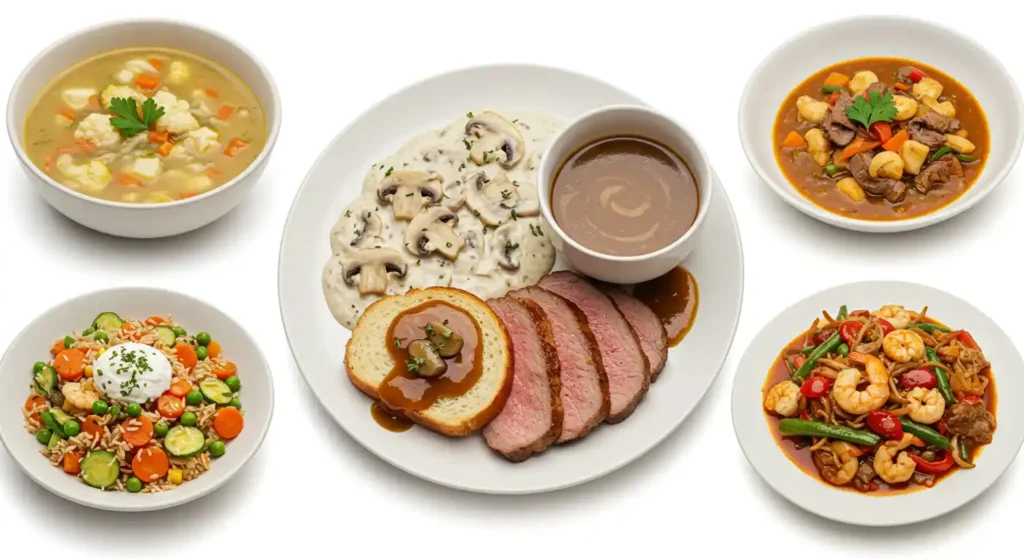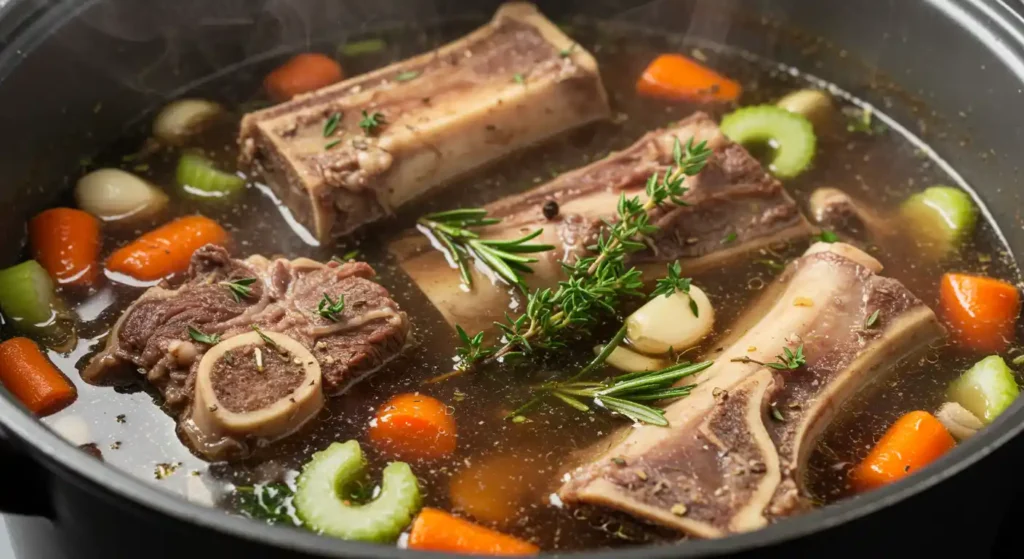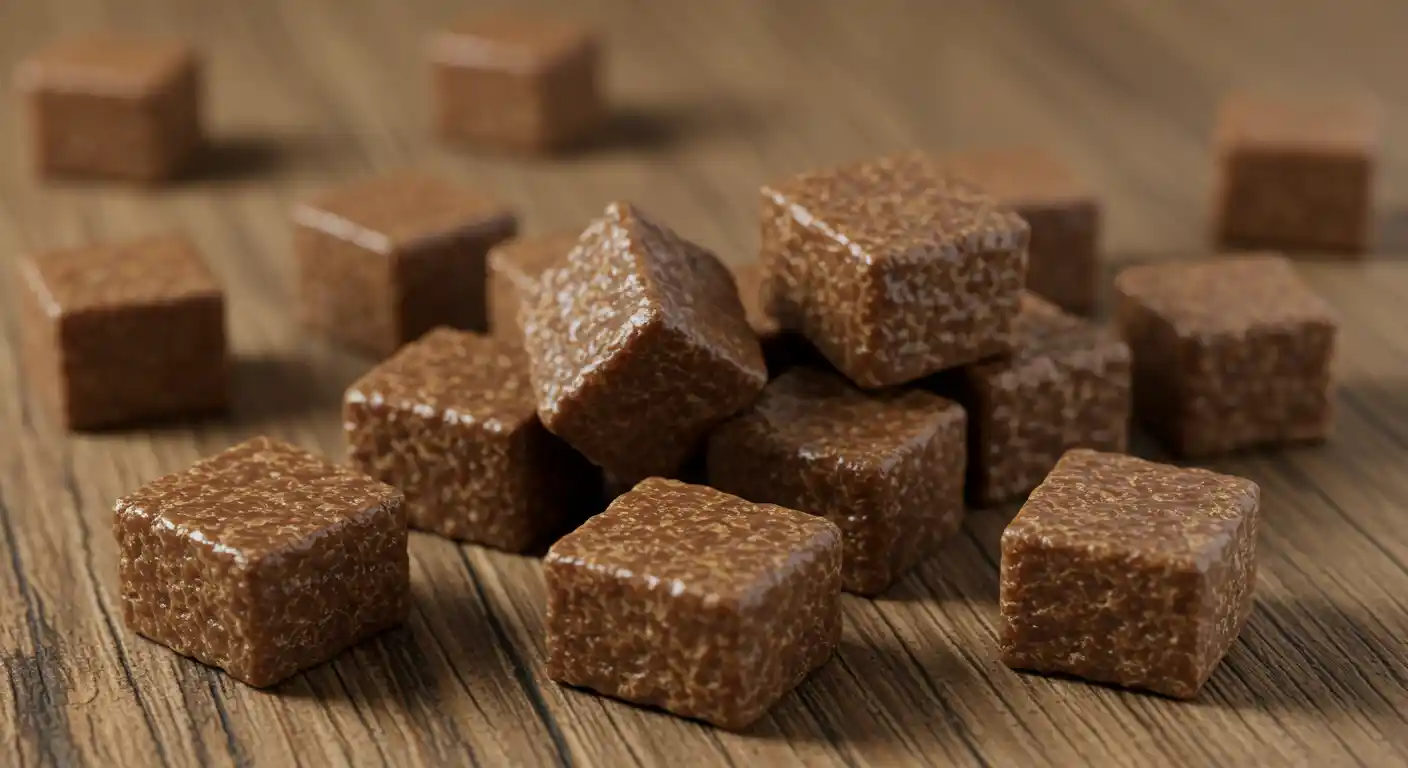Beef bouillon is a concentrated seasoning made by simmering beef, vegetables, and aromatics until rich flavors develop. This savory staple boosts taste in soups, sauces, and marinades. At the present time, many home cooks rely on beef bouillon cubes or granules for convenience and efficiency. Therefore, if you want a quick flavor upgrade, consider stocking your pantry with a trusty supply of this meaty essence.
In this article, we’ll explore everything you need to know about beef bouillon. You’ll discover its origins, different types, simple ways to use it, and much more. We’ll also share a few jokes along the way, so your reading time feels as enjoyable as your cooking. To sum up, this guide ensures you can easily incorporate beef bouillon into your favorite recipes. Keep reading to master the art of flavor.
What Is beef bouillon?
Beef bouillon refers to a liquid or solid form of concentrated beef stock. Traditionally, cooks simmer beef bones, meat trimmings, water, and vegetables like onions, carrots, and celery. Then, they reduce the mixture to a richly flavored broth. In contrast, modern versions include cubes or powders, which dissolve quickly into hot water.
Moreover, beef bouillon brings a robust, savory depth to dishes. Because of its versatility, you can use it in soups, gravies, casseroles, and even mashed potatoes. In the meantime, you can choose between homemade bouillon or premade products. Each approach suits different lifestyles and cooking preferences.
A Brief History of Bouillon
Culinary historians believe bouillon dates back to the days when people first realized broth could enhance taste. Furthermore, chefs in medieval times discovered the benefits of reducing bones and meat to create a concentrated stock. Eventually, the French term “bouillon” emerged, meaning “to boil.” Thanks to cultural exchanges, this technique spread worldwide.
In modern America, beef bouillon became widely popular during the mid-20th century. At that time, companies started producing concentrated cubes or granules. As a result, convenience soared, and busy families embraced the quick solution to add flavor. To demonstrate, dropping a single cube of beef bouillon into a stew provided an instant taste boost without hours of simmering.
Key Reasons to Use beef bouillon
- Convenience
In contrast to homemade stock, bouillon saves time. Simply dissolve a cube or spoonful of powder in hot water. - Flavor Boost
It enriches soups, sauces, and other dishes with a deep, meaty taste. For instance, add a dash when your stew tastes flat. - Versatility
You can use beef bouillon for casseroles, stir-fries, soups, and gravy. Hence, it’s an all-in-one seasoning. - Long Shelf Life
If stored properly, bouillon cubes or powders can last for months. In addition, they require minimal space. - Cost-Effective
Buying premade beef bouillon can be cheaper than purchasing bones and meat to make stock from scratch.
Types of beef bouillon
1. Cubes
These are compressed blocks of dehydrated beef flavor and salt. They dissolve quickly in hot water, forming a savory broth. First, unwrap a cube, then drop it into your dish or hot liquid. Cubes often suit travelers and outdoors enthusiasts. Because of their size, they’re easy to carry anywhere.
2. Granules
Granules are similar to cubes, yet they come in a coarse powder form. They dissolve faster, allowing you to measure out precise amounts. Therefore, many people enjoy using granules when they need fine control over salt content and flavor intensity.
3. Paste
Some brands offer beef bouillon in a paste form. This thick mixture typically comes in jars. It usually contains beef stock concentrate, salt, and flavor enhancers. You can spoon small quantities into water or directly into your dish. In contrast to cubes, paste often has a fresher taste and aroma.
4. Homemade Concentrate
If you love cooking from scratch, try making homemade beef bouillon concentrate. Simmer beef bones with vegetables, herbs, and minimal salt for hours. Strain the liquid, then reduce it until it thickens. Eventually, store it in ice cube trays. This option requires time but offers full control over ingredients.
How to Use beef bouillon
1. Soups and Stews
Add dissolved beef bouillon cubes or granules to your broth. For instance, incorporate it into a classic vegetable soup to intensify the flavor profile. Because it’s so potent, start with small amounts, then taste and adjust accordingly.
2. Sauces and Gravies
Melt a beef bouillon cube into your gravy base to boost the meaty tone. In contrast, if you’re making a simple pan sauce, sprinkle a pinch of granules while deglazing. This ensures a richer taste without the need for extra salt.
3. Marinades
Combine beef bouillon paste or granules with oil, vinegar, and spices. Soak your steak or roast in the mixture for a few hours. As a result, you’ll create a more tender, succulent dish.
4. Rice, Quinoa, and Other Grains
Replace water with beef bouillon broth when cooking grains. Eventually, you’ll get a savory side dish that complements many proteins. For example, add a dash of bouillon to your rice cooker for a flavorful twist.
5. Mashed Potatoes
Mashed potatoes become even more delicious with a hint of beef bouillon. To demonstrate, dissolve half a cube in warm milk before mixing it into boiled potatoes. The result is a hearty, comforting side dish.

Selecting the Best beef bouillon Products
- Check the Ingredient List
Opt for products with real beef extracts. In addition, look for minimal additives and preservatives. - Consider Sodium Content
Some brands can be high in salt. Therefore, if you’re salt-sensitive, choose low-sodium versions. - Look for Organic and Natural Options
Many brands now offer organic choices. Furthermore, these often have cleaner ingredient profiles. - Compare Formats
Cubes, granules, or paste: pick the one that fits your style. For instance, cubes are great on the go, while granules allow precise measurement at home.
Homemade beef bouillon Recipe (Concentrate Version)
Do you want complete control over flavor and ingredients? Try this simple recipe.
Ingredients
- 2 pounds of beef bones (preferably with marrow)
- 1 pound of beef stew meat, cut into chunks
- 1 large onion, roughly chopped
- 2 carrots, chopped
- 2 celery stalks, chopped
- 2 bay leaves
- 1 teaspoon black peppercorns
- Water to cover
- Salt to taste (add at the end)
Instructions
- Roast the Bones and Meat
Preheat your oven to 400°F (200°C). Place the bones and stew meat on a baking sheet. Roast for 30 minutes or until browned. - Combine All Ingredients
Transfer the roasted bones and meat to a large stockpot. Add the onion, carrots, celery, bay leaves, and peppercorns. In the meantime, pour enough water to cover everything. - Simmer Gently
Bring the mixture to a boil, then reduce the heat to low. Skim off any foam that rises. Let it simmer for about 4–6 hours. - Strain and Reduce
Strain the liquid through a fine mesh sieve. Return the strained liquid to the pot and simmer until it reduces by half or more. Eventually, the flavor will intensify. - Season and Store
Add salt to taste. Then, pour the concentrate into ice cube trays. Freeze until solid. Store the cubes in a sealable freezer-safe bag. Use one cube for every cup of water in recipes.
In contrast to store-bought versions, homemade concentrate might not be shelf-stable. Keep it in the freezer to maintain freshness. Furthermore, homemade concentrate offers a purer taste and fewer additives.

Time for a Quick Joke!
Cooking can be serious business. However, a dash of humor can spice things up. Ready for a silly cooking joke?
Joke: Why did the pot call the bouillon cube silly?
Answer: Because it was always “stock” in the past!
We promise our beef bouillon jokes are fresher than leftover stew. Now, let’s get back to the savory details.
Nutritional Data for beef bouillon
Below is an approximate nutritional breakdown per 1 cup (240 ml) of prepared beef bouillon (made from a typical cube or granules). Please note that values may vary depending on the brand or homemade recipe.
| Nutrient | Amount |
|---|---|
| Calories | 10-15 kcal |
| Protein | 1-2 g |
| Carbohydrates | <1 g |
| Total Fat | 0-1 g |
| Sodium | 800-900 mg |
| Potassium | 50-80 mg |
These numbers are approximate and should be used as a guide only. For accurate data, consult the specific product label or a reliable source like USDA.gov (external link).
Why beef bouillon Fits Perfectly in American Cuisine
In American homes, comfort food often involves hearty stews, casseroles, and slow-cooked meals. Beef bouillon seamlessly boosts the taste of these dishes. It adds depth to pot roasts, chili, and gravy-based meals. Because of its convenience, busy families can quickly enhance recipes without extensive prep.
Furthermore, many classic American recipes use a broth base. Adding a cube of beef bouillon is a quick shortcut. In addition, it’s easy to keep a stock of cubes or granules in the pantry. To illustrate, you can make a quick gravy to drizzle over mashed potatoes or roast beef. The bouillon merges flavors, resulting in a satisfying meal that feels home-cooked and comforting.
Flavor Variations and Pairings
Although beef bouillon shines on its own, you can experiment with other flavors:
- Herbal Notes
Stir in fresh thyme or rosemary for a lovely aromatic touch. Eventually, it tastes wonderful in shepherd’s pie. - Spicy Kick
Add cayenne pepper or red pepper flakes to your bouillon-based sauce. In contrast, a small dose of chili can wake up your taste buds. - Umami Boost
Mix in a splash of soy sauce or Worcestershire sauce for extra depth. However, watch the salt content to avoid an overly salty dish. - Rustic Vegetables
Combine onion, carrots, and celery with beef bouillon to create a robust vegetable soup. For instance, top with crunchy croutons for a textural contrast.
Common Mistakes to Avoid
1. Over-Salting Your Dish
Beef bouillon often contains salt. Therefore, taste your dish before adding extra salt. You can always add more, but it’s much harder to fix an overly salty meal.
2. Using Too Many Cubes
Don’t assume that more cubes mean better flavor. In fact, too many cubes can create an overwhelming or artificial taste. Start with the recommended amount, then adjust after tasting.
3. Forgetting to Dissolve Properly
Granules or cubes must fully dissolve. In the meantime, stir well to ensure even distribution. Otherwise, you may end up with salty pockets.
4. Neglecting Quality
Low-quality bouillon might contain artificial flavors, excessive fillers, and MSG. If possible, choose brands that use real beef extracts and simpler ingredient lists.
5. Relying on Bouillon Alone
Beef bouillon is a flavor enhancer, not a substitute for fresh ingredients. Hence, always include real vegetables, herbs, and spices for a balanced dish.
Storing and Reheating Tips
- Store Cubes/Granules in a Cool, Dry Place
Keep them in a sealed container away from moisture and heat. - Use Homemade Concentrate within 3 Months
Frozen cubes maintain quality for about three months. In contrast, store-bought cubes often last longer. - Reheat Safely
If you prepare beef bouillon as a liquid and have leftovers, keep it in the fridge for up to three days. Always reheat to a rolling boil before consuming. - Avoid Cross-Contamination
Use clean utensils. Do not directly dip a dirty spoon into a jar of bouillon paste. This helps maintain freshness and quality.
Frequently Asked Questions
What’s the difference between beef bouillon and beef stock?
Beef stock is a gently simmered liquid from bones, meat, and aromatics. Beef bouillon is a concentrated form. In other words, bouillon is often dehydrated or reduced further than stock.
How long does beef bouillon last once opened?
If it’s in cube or granule form and stored properly, up to a year or more. However, always check the expiration date. For paste, it may last a few months in the fridge after opening.
Is there a vegetarian alternative for beef bouillon?
Yes, many brands offer vegetable or mushroom bouillon. In contrast, the flavor profile differs, but it’s a great plant-based substitute.
Can I drink beef bouillon by itself?
Certainly. Some people sip warm beef bouillon as a light snack or warm beverage. Because it’s so savory, it can be quite comforting.
Will homemade beef bouillon taste better than store-bought?
Often, yes. However, it takes time and effort. Store-bought can be convenient for busy lifestyles.
Conclusion: Master the Art of beef bouillon
Beef bouillon stands as a versatile, cost-effective way to elevate your favorite dishes. In conclusion, whether you opt for cubes, granules, or homemade concentrate, you’ll enjoy a delicious boost of savory goodness. Ultimately, the choice depends on your preference, time, and dietary considerations. At the present time, with so many options available, there’s a beef bouillon solution for every cook.
Experiment with different brands and recipes until you discover the perfect fit. Because bouillon offers a flavor shortcut, you can focus on creating memorable meals in less time. To sum up, let beef bouillon be your secret weapon for richer stews, gravies, and endless culinary possibilities.
